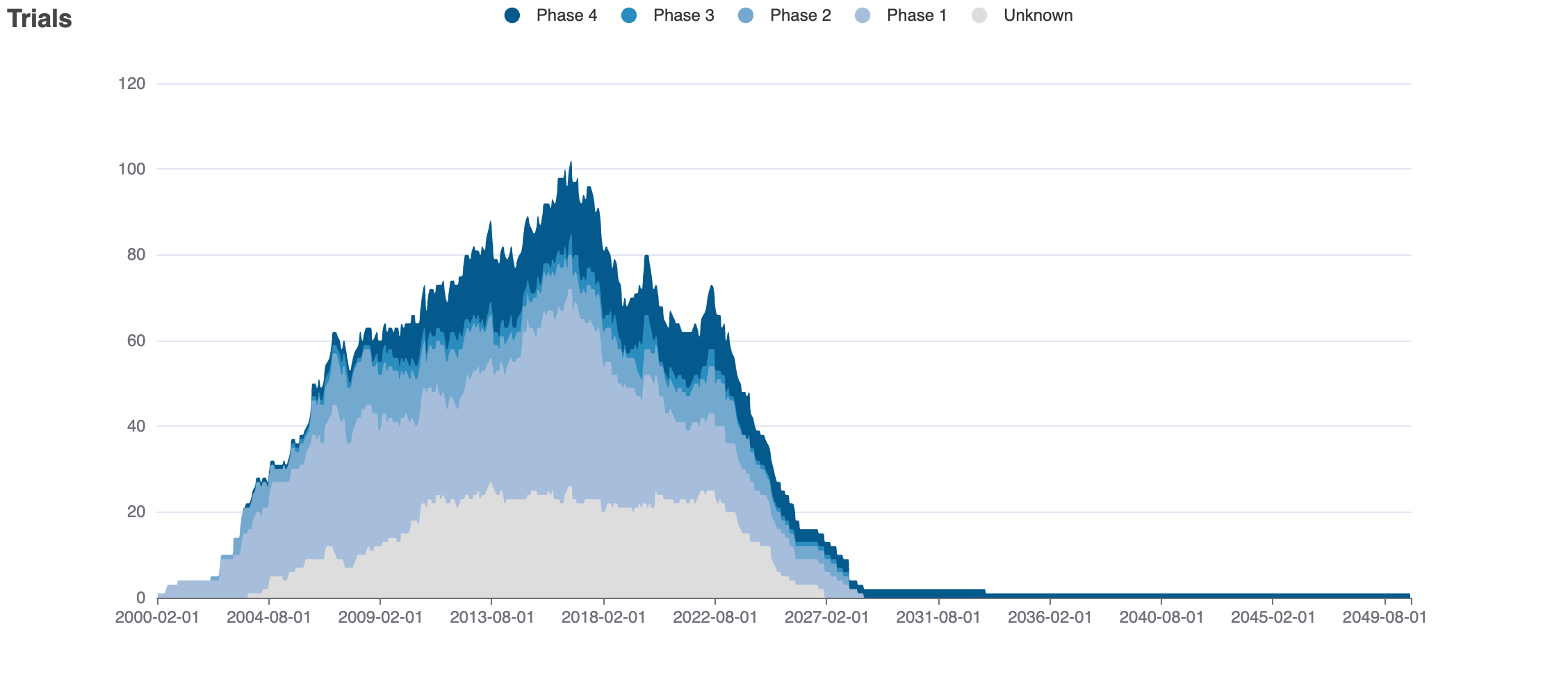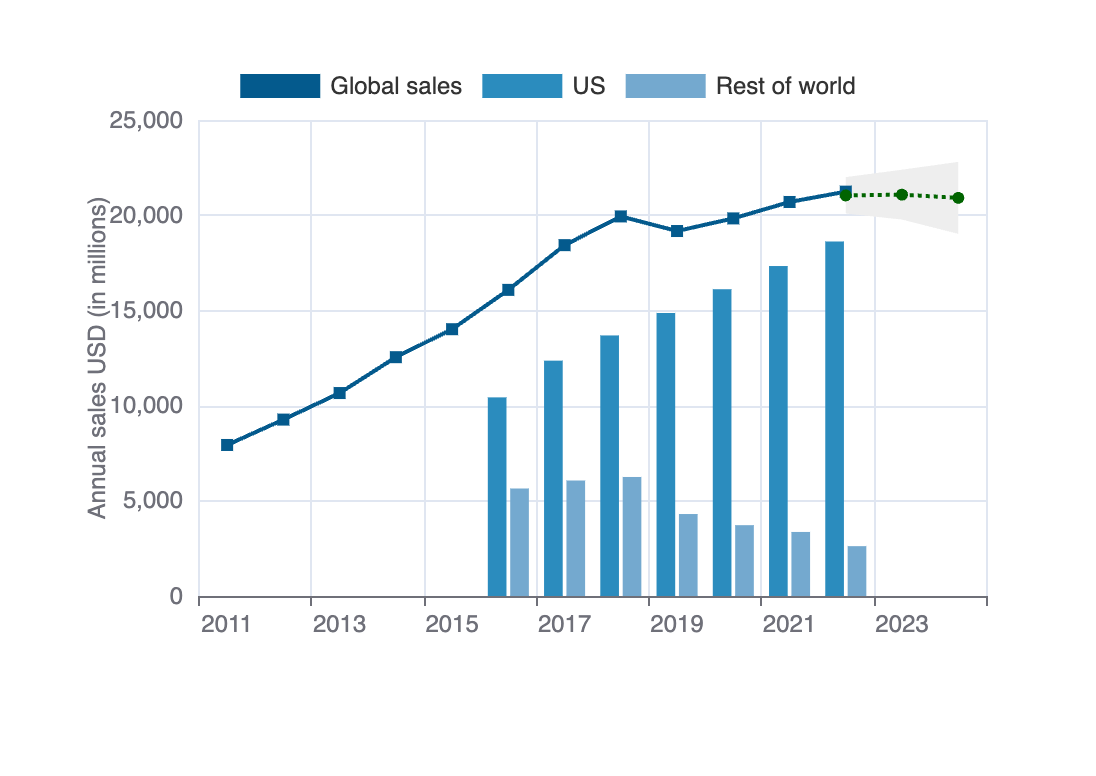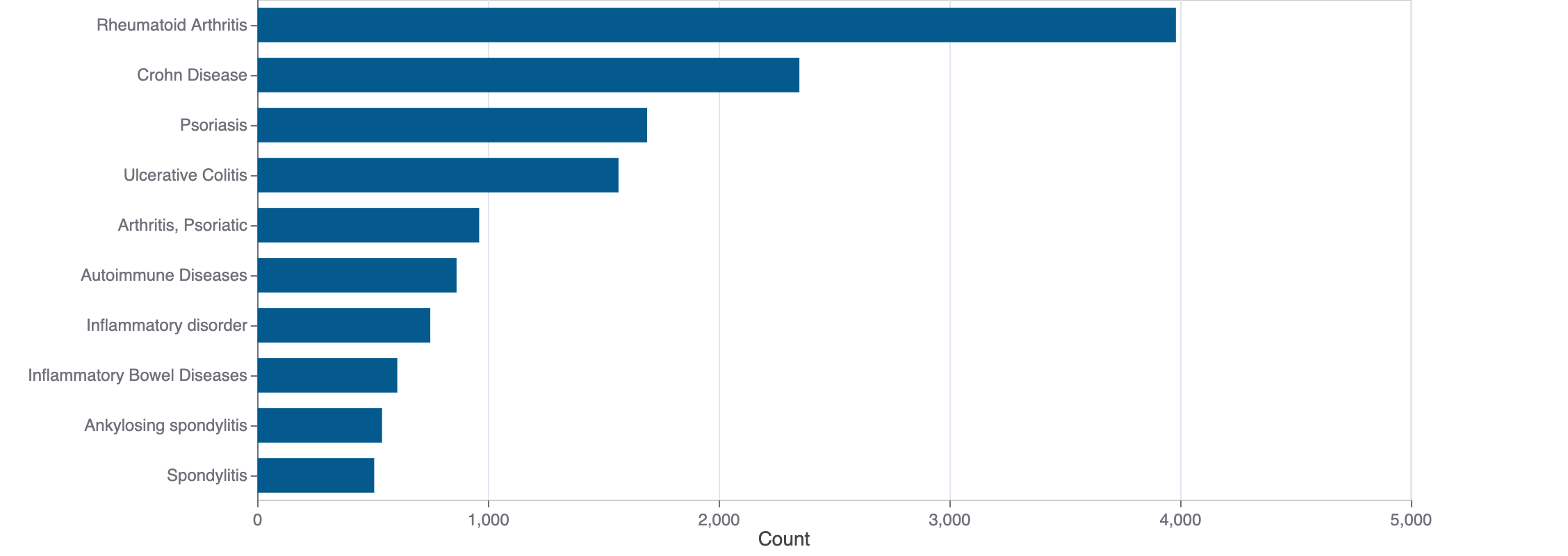Rozlytrek(entrectinib)
Rozlytrek (entrectinib) is a small molecule pharmaceutical. Entrectinib was first approved as Rozlytrek on 2019-08-15. It is used to treat non-small-cell lung carcinoma in the USA. It has been approved in Europe to treat neoplasms and non-small-cell lung carcinoma.
Download report
Favorite
Events Timeline
Commercial
Clinical
Drug
Target
Variants
Financial
Trends
Safety
Events Timeline
5D
1M
3M
6M
YTD
1Y
2Y
5Y
Max
Events
FDA approval date
EMA approval date
Patent expiration date
Study first post date
Last update post date
Start date
Primary completion date
Completion date
Results first post date

Mock data
Subscribe for the real data
Subscribe for the real data
Commercial
Therapeutic Areas
Therapeutic Area | MeSH |
|---|---|
| neoplasms | D009369 |
| respiratory tract diseases | D012140 |
Trade Name
FDA
EMA
Rozlytrek
Drug Products
FDA
EMA
Labels
FDA
EMA
Brand Name | Status | Last Update |
|---|---|---|
| rozlytrek | New Drug Application | 2025-12-04 |
Indications
FDA
EMA
Indication | Ontology | MeSH | ICD-10 |
|---|---|---|---|
| non-small-cell lung carcinoma | — | D002289 | — |
Agency Specific
FDA
EMA
Expiration | Code | ||
|---|---|---|---|
ENTRECTINIB, ROZLYTREK, GENENTECH INC | |||
| 2030-10-20 | ODE-448 | ||
| 2026-10-20 | NP, NPP | ||
| 2026-08-15 | ODE-265, ODE-313 | ||
| 2024-08-15 | NCE | ||
Patent Expiration
Patent | Expires | Flag | FDA Information |
|---|---|---|---|
| Entrectinib, Rozlytrek, Genentech Inc | |||
| 10398693 | 2038-07-18 | DP | |
| 11253515 | 2038-07-18 | DP | |
| 10738037 | 2037-05-18 | DS, DP | U-2946 |
| 11091469 | 2037-05-18 | U-2617, U-2618 | |
| 10561651 | 2035-02-19 | U-2745 | |
| 10231965 | 2035-02-17 | U-2617, U-2618 | |
| 9085565 | 2033-05-22 | DS, DP | |
| 9649306 | 2033-05-22 | U-2617, U-2618 | |
| 8299057 | 2029-03-01 | DS, DP | |
| 8673893 | 2028-07-08 | U-2617, U-2618 | |
| 9029356 | 2028-07-08 | DS, DP | |
| 9085558 | 2028-07-08 | DP | |
| 9255087 | 2028-07-08 | U-2617, U-2618 | |
| 9616059 | 2028-07-08 | U-2618 | |
HCPCS
No data
Clinical
Clinical Trials
45 clinical trials
View more details

Mock data
Subscribe for the real data
Subscribe for the real data
Indications Phases 4
No data
Indications Phases 3
Indication | MeSH | Ontology | ICD-10 | Ph 1 | Ph 2 | Ph 3 | Ph 4 | Other | Total |
|---|---|---|---|---|---|---|---|---|---|
| Neoplasms | D009369 | — | C80 | 3 | 8 | 3 | — | 2 | 13 |
| Non-small-cell lung carcinoma | D002289 | — | — | — | 2 | 3 | — | — | 4 |
| Brain neoplasms | D001932 | EFO_0003833 | C71 | 1 | 4 | 1 | — | — | 4 |
| Melanoma | D008545 | — | — | — | 3 | 1 | — | — | 3 |
| Glioma | D005910 | EFO_0000520 | — | 1 | 3 | 1 | — | — | 3 |
| Neoplasms by site | D009371 | — | — | — | 3 | 2 | — | — | 3 |
| Hematologic neoplasms | D019337 | — | — | — | 2 | 2 | — | — | 2 |
| Lymphoproliferative disorders | D008232 | Orphanet_2442 | D47.9 | — | 2 | 2 | — | — | 2 |
| Neoplasms by histologic type | D009370 | — | — | — | 2 | 2 | — | — | 2 |
Indications Phases 2
Indication | MeSH | Ontology | ICD-10 | Ph 1 | Ph 2 | Ph 3 | Ph 4 | Other | Total |
|---|---|---|---|---|---|---|---|---|---|
| Sarcoma | D012509 | — | — | 1 | 3 | — | — | 1 | 4 |
| Neoplasm metastasis | D009362 | EFO_0009708 | — | 2 | 1 | — | — | 2 | 4 |
| Salivary gland neoplasms | D012468 | EFO_0003826 | D11 | 1 | 3 | — | — | — | 3 |
| Papillary thyroid cancer | D000077273 | — | — | 1 | 3 | — | — | — | 3 |
| Colorectal neoplasms | D015179 | — | — | — | 2 | — | — | — | 2 |
| Breast neoplasms | D001943 | EFO_0003869 | C50 | — | 2 | — | — | — | 2 |
| Ovarian neoplasms | D010051 | EFO_0003893 | C56 | — | 2 | — | — | — | 2 |
| Pancreatic neoplasms | D010190 | EFO_0003860 | C25 | — | 2 | — | — | — | 2 |
| Head and neck neoplasms | D006258 | — | — | — | 2 | — | — | — | 2 |
| Cholangiocarcinoma | D018281 | — | C22.1 | — | 2 | — | — | — | 2 |
Show 29 more
Indications Phases 1
Indication | MeSH | Ontology | ICD-10 | Ph 1 | Ph 2 | Ph 3 | Ph 4 | Other | Total |
|---|---|---|---|---|---|---|---|---|---|
| Liver failure | D017093 | — | K72.9 | 1 | — | — | — | — | 1 |
| Hepatic insufficiency | D048550 | — | — | 1 | — | — | — | — | 1 |
Indications Without Phase
No data
Epidemiology
Epidemiological information for investigational and approved indications
View more details
Drug
General
| Drug common name | Entrectinib |
| INN | entrectinib |
| Description | Entrectinib is a member of the class of indazoles that is 1H-indazole substituted by [4-(4-methylpiperazin-1-yl)-2-(tetrahydro-2H-pyran-4-ylamino)benzoyl]amino and 3,5-difluorobenzyl groups at positions 3 and 5, respectively. It is a potent inhibitor of TRKA, TRKB, TRKC, ROS1, and ALK (IC50 values of 0.1 to 1.7 nM), and used for the treatment of NTRK, ROS1 and ALK gene fusion-positive solid tumours. It has a role as an antineoplastic agent, an EC 2.7.10.1 (receptor protein-tyrosine kinase) inhibitor, an antibacterial agent and an apoptosis inducer. It is a difluorobenzene, a member of indazoles, a member of benzamides, a N-methylpiperazine, a member of oxanes, a secondary amino compound and a secondary carboxamide. |
| Classification | Small molecule |
| Drug class | tyrosine kinase inhibitors: tropomyosin receptor kinase (TRK) inhibitors |
| Image (chem structure or protein) |  |
| Structure (InChI/SMILES or Protein Sequence) | CN1CCN(c2ccc(C(=O)Nc3n[nH]c4ccc(Cc5cc(F)cc(F)c5)cc34)c(NC3CCOCC3)c2)CC1 |
Identifiers
| PDB | — |
| CAS-ID | 1108743-60-7 |
| RxCUI | — |
| ChEMBL ID | CHEMBL1983268 |
| ChEBI ID | — |
| PubChem CID | 25141092 |
| DrugBank | DB11986 |
| UNII ID | L5ORF0AN1I (ChemIDplus, GSRS) |
Target
No data
Variants
No data
Financial
Revenue by drug
$
€
£
₣
Rozlytrek – Roche


Mock data
Subscribe for the real data
Subscribe for the real data

Mock data
Subscribe for the real data
Subscribe for the real data
Tabular view
Estimated US medical usage
No data
Trends
PubMed Central
Top Terms for Disease or Syndrome:

Mock data
Subscribe for the real data
Subscribe for the real data
Additional graphs summarizing 3,616 documents
View more details
Safety
Black-box Warning
No Black-box warning
Adverse Events
Top Adverse Reactions

Mock data
Subscribe for the real data
Subscribe for the real data
1,359 adverse events reported
View more details
© 2020-2025 Collaborative Drug Discovery Inc. (CDD) | Terms of Use